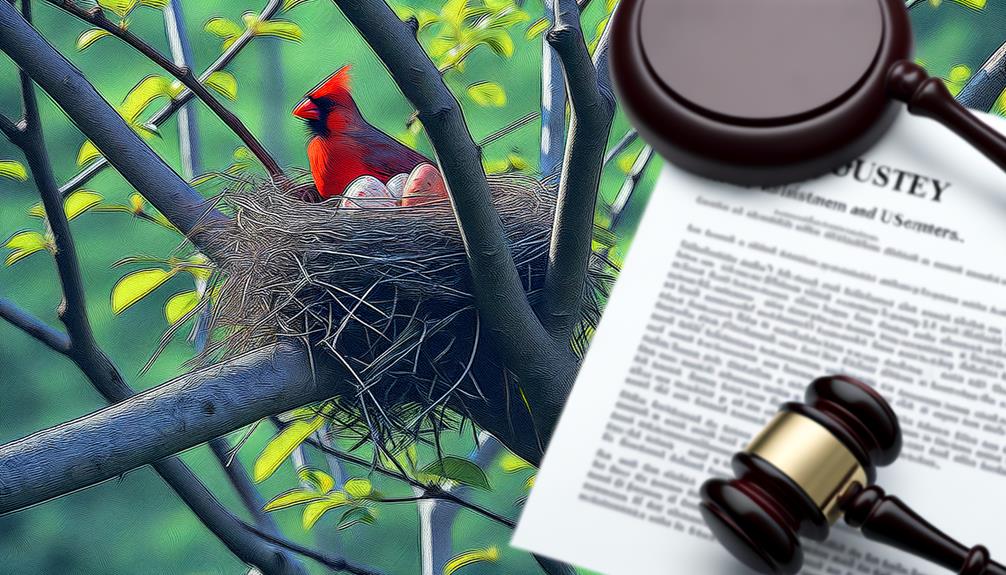How You Safely Move a Cardinal Nest with Eggs – Step-by-Step Guide
You shouldn't move a cardinal nest with eggs since it's usually illegal under the Migratory Bird Treaty Act. Removing the nest disrupts the breeding cycle, leading to nest abandonment and stress for the adult birds.
It also increases the threat from predators and environmental hazards. If the nest is in a problematic location, consider alternatives like creating a protective barrier or educating others about its importance.
For those interested in safe practices and detailed guidance on maneuvering such delicate situations, there's more you can explore.

Key Takeaways
- Moving a cardinal nest with eggs without a permit is illegal under the MBTA.
- Relocating a nest can disrupt the breeding cycle and cause nest abandonment.
- Handling nests can stress adult cardinals and expose eggs to predators.
- Permits for moving nests are rarely granted and mostly for research or conservation.
- Alternatives include creating protective barriers or educating others about the nest's presence.
Legal Considerations

Before attempting to relocate a cardinal nest with eggs, you must familiarize yourself with the legal protections provided to these birds under the Migratory Bird Treaty Act (MBTA).
The MBTA makes it illegal to disturb, move, or handle the nests, eggs, or birds of any species listed under its protection without a permit. These permits are rarely granted and typically only for scientific research or conservation purposes. Ignoring these regulations can result in severe penalties, including fines and imprisonment.
It's essential to make sure you're not inadvertently violating federal law. By understanding and respecting these legal boundaries, you can make informed decisions while maintaining your freedom and avoiding legal repercussions. Always prioritize the birds' wellbeing within the legal framework.
Impact on Cardinals
Moving a cardinal nest with eggs can severely disrupt the birds' breeding cycle and lead to abandonment of the nest. When you move a nest, you create stress for the adult cardinals, which can result in them leaving the eggs unattended. This exposes the eggs to predators and environmental hazards, reducing their chances of survival.
Cardinals rely on familiar surroundings for feeding and protecting their young. Relocating the nest means the parents mightn't recognize the new location or feel safe enough to return. This disruption can halt the development of the embryos and lead to a failed breeding season.
Interfering with the nest not only impacts the current generation but can also affect the future population of cardinals.
Safe Relocation Practices

Guaranteeing the safe relocation of a cardinal nest with eggs demands meticulous planning and a deep understanding of the birds' natural behaviors and needs.
First, identify a suitable new location that mirrors the original concerning height, cover, and proximity to food sources. Cardinals prefer dense foliage, so choose a spot with ample shelter.
Use gloves to minimize human scent and gently transfer the nest to avoid disturbing the eggs. Monitor the new site to confirm the parents accept it.
Keep in mind that even with careful planning, there's a risk the birds might abandon the nest. Your actions should prioritize the birds' well-being, respecting their role in the ecosystem and adhering to local wildlife regulations.
Alternatives to Moving Nests
Considering alternatives to moving a cardinal nest with eggs can greatly reduce the risk of abandonment and stress for the birds. One effective strategy is to create a protective barrier around the nest. Use natural materials like branches or shrubs to shield it from potential predators without disturbing the nest's location.
Another option is to temporarily restrict access to the area, ensuring minimal human intrusion. Educate others about the nest's presence and importance, so they can consciously avoid the area.
Additionally, installing a birdhouse nearby can provide a safer, more controlled environment for future nesting. By implementing these measures, you can help protect the cardinal family while maintaining their natural habitat and minimizing disruption.
What to Do Next

To proceed effectively with relocating a cardinal nest with eggs, first assess the new location to verify it meets the bird's habitat requirements. Confirm the area is safe from predators, has adequate food sources, and provides sufficient cover.
Next, use gloves to gently handle the nest, minimizing human scent transfer. Relocate the nest during a time when the parents are away to avoid distressing them. Secure the nest in a similar structure, like a tree or bush, at a comparable height.
Observe from a distance to validate the parents return to care for the eggs. If they don't return within a few hours, you might need to intervene or contact a wildlife expert for guidance.
Conclusion
To conclude, you shouldn't relocate a cardinal nest with eggs. It's not only illegal but also harmful to the birds' well-being.
You might find leaving the nest undisturbed inconvenient, but think about the greater harm moving it can inflict. Instead, try to coexist by establishing a barrier for protection.
Keep in mind, conserving wildlife maintains ecological balance. Now, take the essential measures to safeguard the nest without disrupting its natural state.






